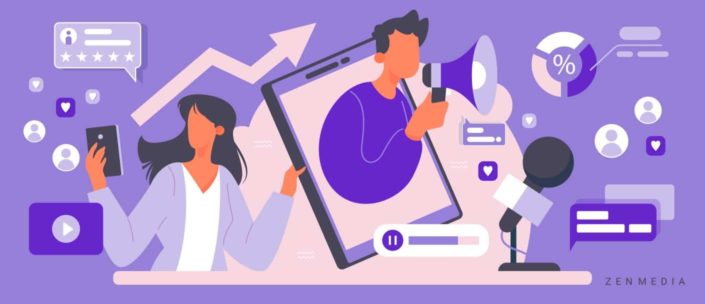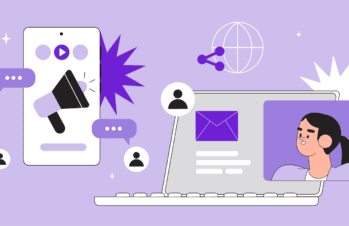Peanut butter and jelly, peas and carrots, PR and social media—some things just go together.
Now, you probably don’t need an explanation as to why those first two things are a perfect match. The third one, however—that’s what we’re going to get into.
Public relations in 2022 requires a multi-pronged approach—one that encompasses not just outreach but also ongoing amplification via (you guessed it) social media.
In this post, we’ll walk you through this critical (but often overlooked) element of the PR campaign process, as well as the short- and long-term benefits it can offer your brand.
Let’s get started!
The first thing to know: PR is much more than press hits
The truth is that social media is integrally intertwined with any marketing or PR strategy a brand may undertake, even if the brand isn’t doing anything itself.
Think about it: if you get a press hit in a major publication, chances are that publication is going to share it on their social media. And even if they don’t share it themselves, readers will. That press hit is only the beginning of what strategic public relations can do for your brand. The field has expanded massively, and with it, the opportunities to reach new audiences in new formats.
This is a highly positive development for brands. It means that any PR you get has a much longer lifespan than it used to. If an interview aired on TV, for example, your audience was whoever saw it when it aired. If you got a quote in a print magazine, your audience was whoever read it when it came out, and then, likely, a slow trickle of readers who picked up the magazine in a doctor’s office or at their hairdresser’s.
Now, if you get an interview on TV, it goes on YouTube or on the show’s website, where it can continue to gain views and interest. So instead of referring mainly to instances of public exposure—the press hit, the speaking engagement—PR today means an ongoing conversation with the public. Press hits are a part of that, certainly, but they should be the starting point, not the end goal.
In other words, social media can amplify your strategic public relations in a way that simply wasn’t possible before. As the digital ecosystem has grown and evolved, so too have the types of opportunities available. Product Hunt campaigns for tech product-based businesses, podcast interviews, livestream Q&A sessions are all ways for brands to get their messages out to a larger audience outside of the traditional PR outlets.
In addition, the goals of social media and PR are the same: to build trust in your company. Because of that, it only makes sense that the two tools work together.
Related post: Why Social Media Marketing Matters for B2B
How should social media marketing fit into your PR campaigns?
When you’re developing a PR campaign or working with a PR agency, there are a few elements to consider:
- Goals: What’s your goal for the campaign?
- Research and Discovery: What’s your angle and where (or to whom) are you pitching?
- Outreach: It’s time to make your moves and send your pitches!
- Amplification: How will you get the most mileage out of every PR success?
Social media can and should be woven into every one of these other elements in order to get your message across faster and more effectively. Here’s how.
Related post: 6 Common Mistakes B2B Brands Make When Pitching Media
Establishing Your PR Goals
Sometimes, figuring out your goal with PR is easy. Suppose you’re launching a product, expanding into new markets or geographic regions, or welcoming a new executive team. In that case, your goal is essentially to generate excitement or attention around that event.
If you’re doing ongoing PR, however, that is not connected to a single event and is designed to boost your brand reputation and increase awareness, narrowing down your goals can be more difficult.
This is where social media can help. Take a look at what your followers are talking about and sharing across different platforms. See what kinds of conversations are trending in your industry. This can help you see what your audience cares about and is interested in, which, in turn, can spur ideas for how to shape your PR strategy.
For example, if you’re seeing a lot of concern around specific ethical issues in your industry, you might focus a PR campaign on your commitment to a social cause.
If you’re looking for talent, you can see what current and potential job seekers are talking about and design a campaign about your work culture.
In general, marketers and PR pros need to keep an eye on social media because that is where your target audience shares their opinions. Besides, scanning social is a great way to generate ideas—you may end up with a great idea for your next PR campaign.
Figuring out your PR angle and finding the right outlets
Just as social media can help you decide on the goal for your digital campaign, social platforms are also a great place to look as you’re coming up with angles to pitch to reporters. In the research and discovery phase, you or your PR agency is researching angles, outlets, journalists, and more to lay the groundwork for your outreach.
Many reporters, as well as popular bloggers and others in the larger media landscape, use Twitter as a way to request story ideas or advertise what beats they’re currently covering. This makes Twitter an excellent resource for not only identifying certain topics, stories, and angles that are more likely to get coverage but also for growing your media list.
You can find relevant reporters by doing hashtag searches—try #editorial, #breaking, and #journalist to start—and don’t forget to search for your industry or topic-related hashtags as well to narrow down the list.
Just as you’d use social media to find reporters, bloggers, and other media personalities or influencers to connect with, you can also use it to identify outlets to pitch.
For this, you’ll want to move beyond Twitter. Check out Instagram, TikTok, and Facebook to see which outlets are covering relevant topics for your brand and add any you find to your media list.
This is also a good way to find reporters, as once you see an outlet you want to connect with, you can also see who’s tagging them in posts. Any writer or creator who works for that outlet will almost certainly tag the outlet when they post about a story they’ve done.
If you’re working with an agency, this is also the time when they’ll be doing research on your brand and getting to know you and your team. This may take the form of interviews with leadership (especially if you’re including thought leadership in your PR efforts), calls with your team and your agency account team, or questionnaires that your team fills out. A strong agency partner will want to get to the Bullet Points & Blessings stage with your company.
Related reading: How To Outsource Your Marketing: Trust Us, We Got This
Pitching Your Stories
This is the outreach stage. It’s time to actually contact the journalists, bloggers, YouTube personalities, interviewers, and others whom you’ve identified in the research phase. Remember, in the research phase, you will have identified the angles each of these contacts is most interested in. Be sure to reference that research when you are pitching so you get the most out of your efforts.
While email is always a good bet, social media actually comes in handy here, as well. Some of the people you want to pitch to will be more open to connecting on a social platform than through email. Some even specify their communication preferences in their profiles.
Pitching is when you secure press opportunities, from interviews to speaking engagements to quotes. Once these engagements have been completed, it’s time to move into the all-important—yet often overlooked—stage: amplification. This is where we see just how powerful social media marketing can be for your brand’s PR efforts.
Related post: The Critical Point Where Most PR Agencies Fail
Amplifying Your PR Hits Via Social Media Marketing
While social media is a useful tool throughout the PR process, from conceptualizing your PR campaign to pitching writers and creators, the amplification stage is where social media marketing is absolutely indispensable.
Each time you get a PR hit, you can drastically extend its lifespan (thereby boosting your ROI) by sharing it on your own social channels.
What’s more, you can use that hit in multiple ways over a long period of time—it’s not just a one-and-done deal. So, if your executive is quoted in an article, you can:
- Share a link to the article on your social platforms, tagging the outlet or writer.
- Create quote cards featuring your quote(s) to use as Instagram posts.
- Create video clips of your executive expanding on the quote to use as posts across your platforms.
- Turn those videos into audio clips and create audiograms for posting across platforms.
- Create facebook business ads with your press hits.
- Use the press to attract influencers.
- Include a link to the press hit in any additional relevant social posts you create as time goes on (such as a blog post you wrote that references the press hit, older content that’s relevant to the topic, etc.).
These are all powerful ways to get more mileage out of every PR opportunity, no matter how big or small. Without social media, your B2B PR efforts will only be giving you a fraction of the results they could be, lowering your overall ROI and making it harder to justify continuing PR campaigns.
The Perfect Pair: Social Media Marketing and PR
By incorporating a social strategy into every step of your PR campaign, you’ll stand a much higher chance of success and keep reaping the benefits for weeks and months to come.
Incorporating a social media marketing strategy into your PR campaigns also allows you to repurpose each press hit and use it to generate even more original content, further boosting your reputation and engagement.
The content is a way to get people interested, and naturally, it’s great if they want to go check it out at the link—but the real purpose here is to boost engagement with your brand on social platforms.
PR engagements can be the missing piece when it comes to getting influencers interested in your brand. When you get a great piece of press, you can connect with B2B influencers you’re interested in via social media, share your press hits, and engage with them. And the more effective and interesting your own social content is, the more likely it is that influencers will want to partner with your brand.
This has the short-term benefit of getting more eyes on your brand and potentially contributing to increased sales and better lead gen.
The long-term benefit, however, is even greater: PR campaigns that include a social element can greatly increase the potential of each and every press hit your brand gets by giving that hit a much longer life than it would have had simply by appearing in the outlet, being shared once, and then fading into the background.
Need some help getting started? Give our team a call!







